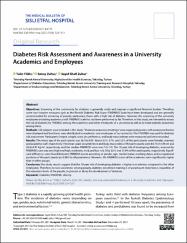| dc.description.abstract | Objectives: Screening of the community for diabetes is generally costly and imposes a significant financial burden. Therefore, some non-invasive measures such as the Finnish Diabetes Risk Score (FINDRISK) Scale have been developed and are generally recommended for screening of people, particularly those with a high risk of diabetes. However, the screening of the university employees including academics with FINDRISK scale has not been performed so far. Therefore, in this study, we intended to assess the risk of diabetes by FINDRISC among the academics and other employees of a university as well as to make diabetes awareness among them. Methods: 442 subjects were included in this study. Diabetes awareness meetingswere organized, posters with awareness themes were displayed and brochures were distributed to academics and employees of our university. The FINDRISK was used for diabetes risk assessment. Participants' height, weight, waist circumference, and body mass indexes were measured and were recorded. Results: The mean age of the participants was 36.76 +/- 9.05. About 62%, 67%, and 32% of the participants were females, married, and academic staff, respectively. The mean waist circumference and body mass index of the participants were 84.71 +/- 14.49 cm and 26.8 +/- 4.91 kg/m2, respectively, and the median FINDRISK score was 7 (3-10). The 10-year risk of developing diabetes, assessed by FINDRISK score was very high and high, moderate, mild, and low in 8, 10.6, 32.4, and 43.9% of the participants, respectively. Significant differences were found between FINDRISK scores according to gender, age, marital status, smoking status, and occupational positions of the participants (p<0.001 for all parameters). However, the FINDRISK scores of the academics were significantly higher than in other groups. Conclusion: Our study results suggest that the 10-year risk of developing diabetes is higher in academics compared to the other employees. Therefore, to raise awareness among people, diabetes prevention training is of paramount importance, regardless of the education levels of the people, to prevent or delay the development of diabetes. | en_US |



















